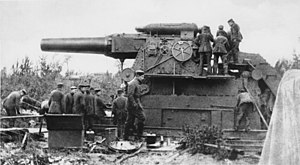
Back Gamma-Gerät BR Kurze Marine-Kanone 12 L/16 (Gamma-Gerät) German Gamma-Gerät French 42 cm Gamma Mörser Italian 42cmガンマ臼砲 Japanese 42 cm Gamma Mörser Dutch Gamma Mörser (гаубица) Russian 420-мм облогова гаубиця Gamma Mörser Ukrainian 42 cm Gamma Mörser VI
| 42cm Gamma-Gerät | |
|---|---|
 A Gamma-Gerät in 1914 | |
| Type | Siege artillery |
| Place of origin | German Empire |
| Service history | |
| In service | 1909–1942 |
| Used by | German Empire Nazi Germany |
| Wars | World War I World War II |
| Production history | |
| Manufacturer | Krupp |
| No. built | 10 |
| Specifications | |
| Mass | 150 t (150 long tons) |
| Length | 13.5 m (44 ft) |
| Barrel length | 6.7 m (22 ft) L/16 |
| Height | 4.25 m (13.9 ft) |
| Diameter | 420 mm (17 in) |
| Elevation | +43° to 75° |
| Maximum firing range | 14,200 m (46,600 ft) |
The 42 cm kurze Marinekanone L/12, or Gamma-Gerät ("Gamma Device"), was a German siege gun built by Krupp. The Gamma-Gerät's barrel diameter was 42 cm (17 in), making it one of the largest artillery pieces ever fielded. The Gamma-Gerät began development in 1906 and entered service with the Imperial German Army in 1911. The Gamma-Gerät was the most powerful piece of artillery fielded by the Imperial German Army, but due to its extreme weight was mostly immobile and could only be emplaced near permanent rail lines. As a result, the Gamma-Gerät had limited effectiveness on the Western and Eastern Fronts of World War I.
A total of ten Gamma-Gerät howitzers were produced, mostly during World War I, and were assigned to a total of six artillery batteries, typically two guns to a battery. These batteries were deployed at various sieges and battles in Belgium, France, Poland, and Serbia. Allied counter-battery fire and internal detonations caused by faulty ammunition reduced the number of extant Gamma-Gerät howitzers to a single gun by the end of World War I. This Gamma-Gerät survived the aftermath of World War I and saw limited use in World War II by the Wehrmacht to attack the Maginot Line and besiege Sevastopol.